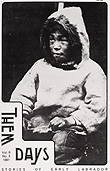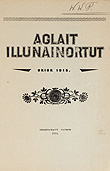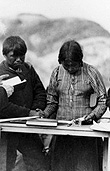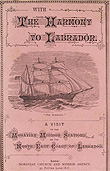
The Inuit have a strong culture, which is remarkably adaptable and supported by a complex, widely-spoken language, however, its written heritage remains little known. This exhibition traces the beginnings of literacy and written literature for the Inuit living in Nunatsiavut (Labrador) and, to a lesser extent, in Nunavik.
Moravian missionaries transcribed biblical texts into a written form of Inuttitut and were the first in Canada to write and publish Inuttitut using Latin characters. In the early 19th century, an Anglican missionary in Northern Quebec (now Nunavik) transcribed parts of these same Moravian biblical translations into syllabic orthography.
Even more importantly, the Moravian missionaries produced text books for the Inuit, allowing them to become literate very early in Canadian history, from the end of the 18th century. The Labrador Inuit were the first Inuit to have written in their own language and thus constitute the beginnings of Inuit written literature in Canada.
This exhibition is part of the "Entendre et communiquer les voix du Nunavik/ Hearing and sharing the voices of Nunavik", a joint Université du Québec à Montréal and McGill University initiative funded by the Canadian program of the International Polar Year (IPY), 2008-2011. (http://www.imaginairedunord.uqam.ca/index.php?section=nunavik)
This exhibition is also supported by a McGill University-SSHRC Institutional grant. It was made possible in part thanks to the AVATAQ Cultural Institute. This exhibition was prepared by Sharon Rankin, Marianne Stenbaek, Lindsay Terry and Jennifer Campbell.






